词义的选择与引申
- 格式:ppt
- 大小:91.00 KB
- 文档页数:22
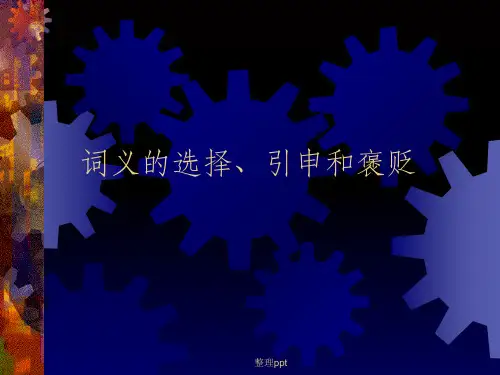
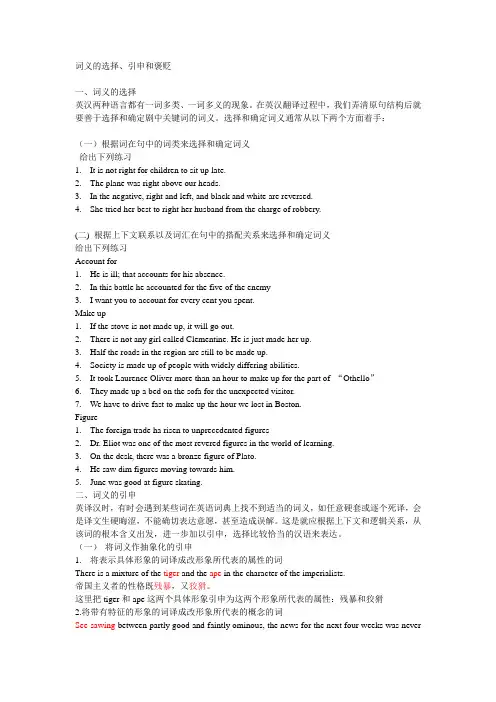
词义的选择、引申和褒贬一、词义的选择英汉两种语言都有一词多类、一词多义的现象。
在英汉翻译过程中,我们弄清原句结构后就要善于选择和确定剧中关键词的词义。
选择和确定词义通常从以下两个方面着手:(一)根据词在句中的词类来选择和确定词义给出下列练习1.It is not right for children to sit up late.2.The plane was right above our heads.3.In the negative, right and left, and black and white are reversed.4.She tried her best to right her husband from the charge of robbery.(二) 根据上下文联系以及词汇在句中的搭配关系来选择和确定词义给出下列练习Account for1.He is ill; that accounts for his absence.2.In this battle he accounted for the five of the enemy3.I want you to account for every cent you spent.Make up1.If the stove is not made up, it will go out.2.There is not any girl called Clementine. He is just made her up.3.Half the roads in the region are still to be made up.4.Society is made up of people with widely differing abilities.5.It took Laurence Oliver more than an hour to make up for the part of “Othello”6.They made up a bed on the sofa for the unexpected visitor.7.We have to drive fast to make up the hour we lost in Boston.Figure1.The foreign trade ha risen to unprecedented figures2.Dr. Eliot was one of the most revered figures in the world of learning.3.On the desk, there was a bronze figure of Plato.4.He saw dim figures moving towards him.5.June was good at figure skating.二、词义的引申英译汉时,有时会遇到某些词在英语词典上找不到适当的词义,如任意硬套或逐个死译,会是译文生硬晦涩,不能确切表达意愿,甚至造成误解。
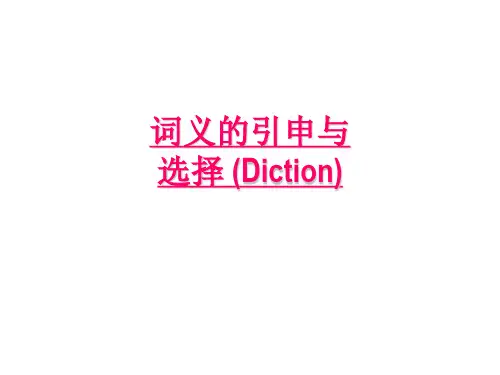
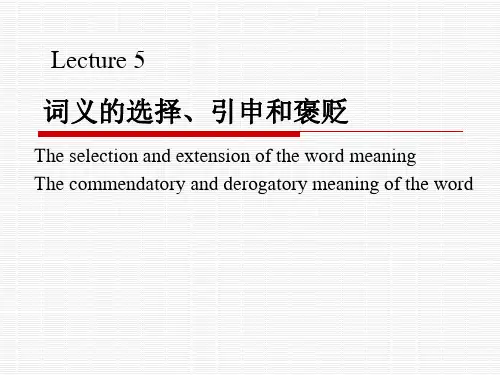
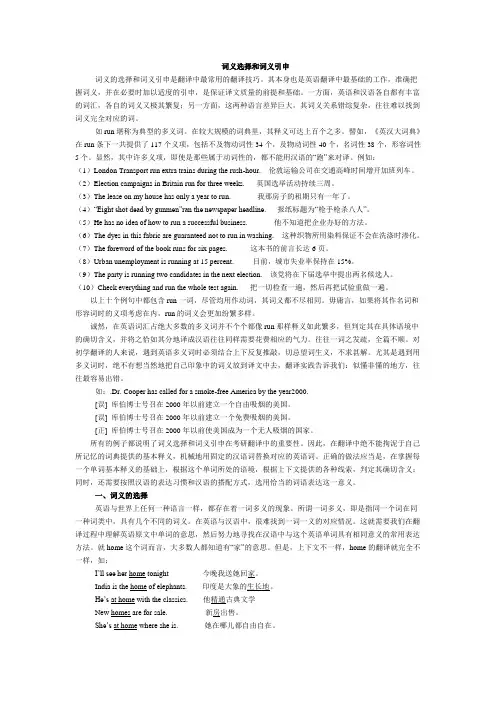
词义选择和词义引申词义的选择和词义引申是翻译中最常用的翻译技巧。
其本身也是英语翻译中最基础的工作,准确把握词义,并在必要时加以适度的引申,是保证译文质量的前提和基础。
一方面,英语和汉语各自都有丰富的词汇,各自的词义又极其繁复;另一方面,这两种语言差异巨大,其词义关系错综复杂,往往难以找到词义完全对应的词。
如run堪称为典型的多义词。
在较大规模的词典里,其释义可达上百个之多。
譬如,《英汉大词典》在run条下一共提供了117个义项,包括不及物动词性34个,及物动词性40个,名词性38个,形容词性5个。
显然,其中许多义项,即使是那些属于动词性的,都不能用汉语的“跑”来对译。
例如:(1)London Transport run extra trains during the rush-hour. 伦敦运输公司在交通高峰时间增开加班列车。
(2)Election campaigns in Britain run for three weeks. 英国选举活动持续三周。
(3)The lease on my house has only a year to run. 我那房子的租期只有一年了。
(4)“Eight shot dead by gunmen”ran the newspaper headline.报纸标题为“枪手枪杀八人”。
(5)He has no idea of how to run a successful business. 他不知道把企业办好的方法。
(6)The dyes in this fabric are guaranteed not to run in washing. 这种织物所用染料保证不会在洗涤时渗化。
(7)The foreword of the book runs for six pages. 这本书的前言长达6页。
(8)Urban unemployment is running at 15 percent. 目前,城市失业率保持在15%。
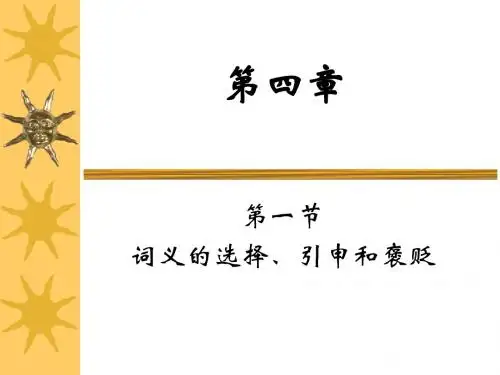

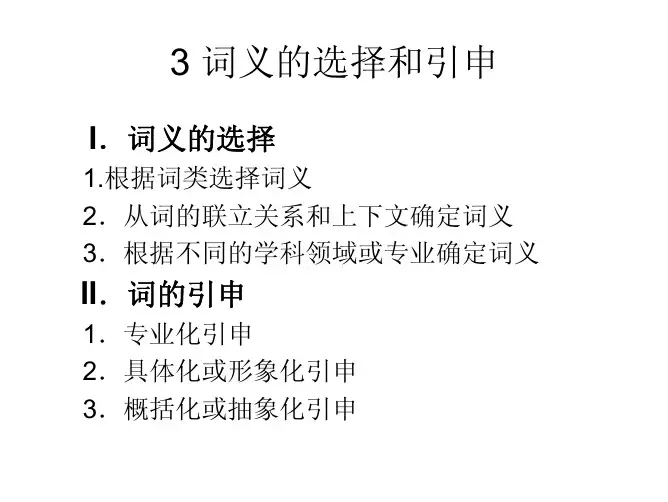
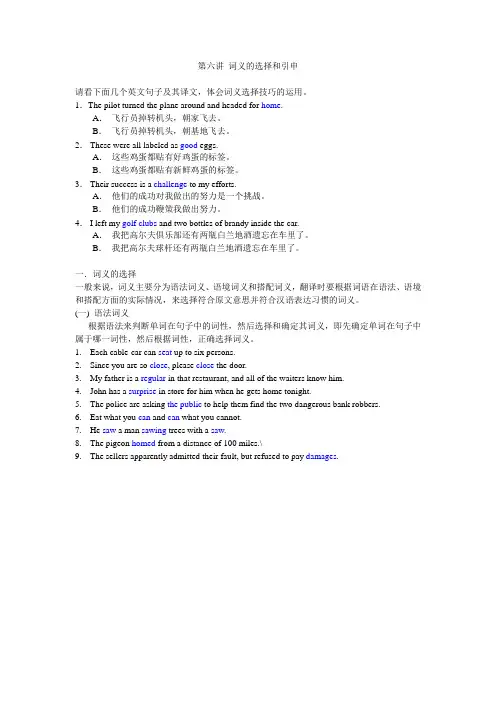
第六讲词义的选择和引申请看下面几个英文句子及其译文,体会词义选择技巧的运用。
1.The pilot turned the plane around and headed for home.A.飞行员掉转机头,朝家飞去。
B.飞行员掉转机头,朝基地飞去。
2.These were all labeled as good eggs.A.这些鸡蛋都贴有好鸡蛋的标签。
B.这些鸡蛋都贴有新鲜鸡蛋的标签。
3.Their success is a challenge to my efforts.A.他们的成功对我做出的努力是一个挑战。
B.他们的成功鞭策我做出努力。
4.I left my golf clubs and two bottles of brandy inside the car.A.我把高尔夫俱乐部还有两瓶白兰地酒遗忘在车里了。
B.我把高尔夫球杆还有两瓶白兰地酒遗忘在车里了。
一.词义的选择一般来说,词义主要分为语法词义、语境词义和搭配词义,翻译时要根据词语在语法、语境和搭配方面的实际情况,来选择符合原文意思并符合汉语表达习惯的词义。
(一) 语法词义根据语法来判断单词在句子中的词性,然后选择和确定其词义,即先确定单词在句子中属于哪一词性,然后根据词性,正确选择词义。
1.Each cable-car can seat up to six persons.2.Since you are so close, please close the door.3.My father is a regular in that restaurant, and all of the waiters know him.4.John has a surprise in store for him when he gets home tonight.5.The police are asking the public to help them find the two dangerous bank robbers.6.Eat what you can and can what you cannot.7.He saw a man sawing trees with a saw.8.The pigeon homed from a distance of 100 miles.\9.The sellers apparently admitted their fault, but refused to pay damages.(二) 语境词义根据单词在上下文语境的意义来选择和确定词义。

词义的选择、引申及褒贬一、词义的选择英汉两种语言都有一词多类、一词多义的现象。
一词多类就是指一个词往往属于几个词类,具有几个不同的意义。
一词多义就是说同一个词在同一个词类中,又往往有几个不同的词义。
在英汉翻译过程中,我们在弄清原句结构后就要善于选择和确定原句中关键词的词义。
选择和确定词义通常从以下两个方面着手:(一)根据词在句中的词类来选择和确定词义选择某个词的词义,首先要判明这个词在原句中应属哪一种词类,然后再进一步确定其词义。
例如,在like charges repel; unlike charges attract一句中,like用作形容词,它的汉语对应意义是“相同的”,因此全句可以译为:“相同的电荷相斥,不同的电荷相吸”。
但在下面各句中,like又分属其他几个不同词类:1)He likes mathematics more than physics.他喜欢数学甚于喜欢物理学。
(动词)2)In the sunbeam passing through the window there are fine grains of dust shining like gold.在射入窗内的阳光里,细微的尘埃像金子一般在闪闪发亮。
(前置词)3)Like knows like.英雄识英雄。
(名词)(二)根据上下文确定词义除了根据词性来判断词义之外,词义选择一个更为重要的方法就是根据上文来判断词义了。
因为很多英语单词即使弄清楚了词性,但仍须从几个或几十个义项中选定确切的词义。
这就需要借助于上下文提供的各种线索做出合理的分析、推理、判断。
有时候,我们还可能会在考试中碰到生词。
可是,我们绝对不会在一个英语句子中出现这种情况:某一个单词不认识,而这个单词上下文中的所有单词都不认识。
正因为上下文的存在,这也给我们翻译中解决生词提供了突破口。
因此,在翻译中,我们一定要随时注意上下文,上下文的不同在很大程度上决定了单词意义的不同,也在很大程度上决定了翻译中理解和表达的正确性、准确性和译文是否通顺。
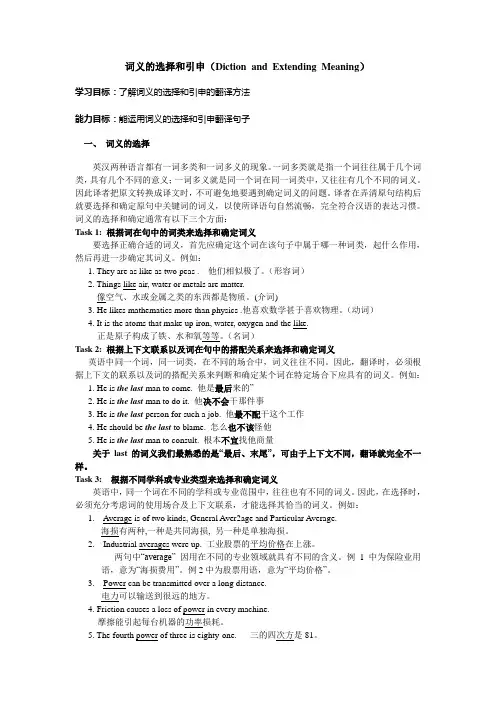
词义的选择和引申(Diction and Extending Meaning)学习目标:了解词义的选择和引申的翻译方法能力目标:能运用词义的选择和引申翻译句子一、词义的选择英汉两种语言都有一词多类和一词多义的现象。
一词多类就是指一个词往往属于几个词类,具有几个不同的意义;一词多义就是同一个词在同一词类中,又往往有几个不同的词义。
因此译者把原文转换成译文时,不可避免地要遇到确定词义的问题。
译者在弄清原句结构后就要选择和确定原句中关键词的词义,以使所译语句自然流畅,完全符合汉语的表达习惯。
词义的选择和确定通常有以下三个方面:Task 1: 根据词在句中的词类来选择和确定词义要选择正确合适的词义,首先应确定这个词在该句子中属于哪一种词类,起什么作用,然后再进一步确定其词义。
例如:1. They are as like as two peas . 他们相似极了。
(形容词)2. Things like air, water or metals are matter.像空气、水或金属之类的东西都是物质。
(介词)3. He likes mathematics more than physics .他喜欢数学甚于喜欢物理。
(动词)4. It is the atoms that make up iron, water, oxygen and the like.正是原子构成了铁、水和氧等等。
(名词)Task 2: 根据上下文联系以及词在句中的搭配关系来选择和确定词义英语中同一个词,同一词类,在不同的场合中,词义往往不同。
因此,翻译时,必须根据上下文的联系以及词的搭配关系来判断和确定某个词在特定场合下应具有的词义。
例如:1. He is the last man to come. 他是最后来的”2. He is the last man to do it. 他决不会干那件事3. He is the last person for such a job. 他最不配干这个工作4. He should be the last to blame. 怎么也不该怪他5. He is the last man to consult. 根本不宜找他商量关于last的词义我们最熟悉的是“最后、末尾”,可由于上下文不同,翻译就完全不一样。
翻译时如何注意词义的选择和引申?翻译时如何注意词义的选择和引申?引导语:翻译时如何注意词义的选择和引申?下面就和店铺一起来看看吧。
一、词义如何选择英文中一词多义的现象非常普遍。
例如:英语story一词在不同的上下文中可以有不同的词义:例:It is quite another story now.现在情况完全不同了。
例:The officials concerned refused to confirm the story in the Post. 有关官员拒绝证实《邮报》的这条消息。
例:The white-haired girl’s story is one of the saddest.白毛女的遭遇可算是最悲惨的。
例:A young man came to police station with a story.一个年轻人来到警察局报案。
遇到英语多义词时必须结合上下文反复推敲,切忌望词生义,不求甚解。
尤其遇到多义常用词时,不要想当然地把自己懂得的词义放到文章中去。
例:Albert Einstein, who developed the theory of relativity, arrived at this theory through mathematics.误: 阿尔伯特·爱因斯坦发展了相对论,他是通过数学方法得出这一理论的。
(此处develop应译为“创立”)再以consequence一词为例,考研真题中该词曾出现过三次:Consequence在三句中的分别译为:“推论”“结果”“影响”。
例: consequenceOthers are reasonable consequences of particular advances in science being to some extent self-accelerating. (1996:71) 其他原因则是由于科学在一定程度上自我加速而取得特定发展的必然结果。
英汉翻译技巧翻译技巧是人们通过翻译实践摸索出来的比较系统的翻译方法。
人们在长期的翻译实践中,发现中外语言在词法、句法等方面有很大区别。
中外学者和翻译家在研究各种语言的互译中,深入总结这些区别,提出了各种各样的翻译技巧。
由于着眼点不同以及探索处理方法上存在差异,他们在英汉翻译技巧的分类和统计方法等方面各不相同。
有人将其分为八大技巧,有人分为九大技巧,有人分为十大技巧,还有人分得更多、更细。
本书拟采用如下九种说法。
这九种说法相对简便易记:(1)词义的选择和引申;(2)增词法;(3)省略法;(4)重复法;(5)转换法;(6)分译法;(7)语序调整法;(8)反译法;(9)被动语态的译法。
本章我们将对这九种翻译技巧逐一进行讲解探讨。
第一节词义的选择和引申在翻译过程中,译者首先要掌握的是如何正确地选择恰当的词语,并在必要时加以适度的引申,只有这样才能确保译文的准确通顺。
这是因为英汉两种语言都有一词多义和一词多类的现象。
例如英语中的run就是典型的多义词。
请看它在下列句子中的词义:(1)Check everything and run the whole experiment again.把一切检查一遍,然后再把实验重做一遍。
(2)The party is running two candidates in the next election.该党将在下届选举中提出两名候选人。
(3)Urban unemployment is running at 15 percent.目前,城市失业率保持在15%。
(4)He has no idea of how to run a successful business.他没有办好企业的办法。
(5)The general election campaign in America ran for three weeks.美国大选活动持续了三周。
以上五个例句中都包含run一词,尽管均用作动词,其词义各不相同。